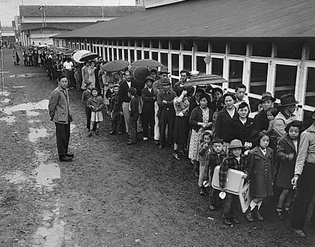LAD/Blog #35: Home was a Horse Stall
LAD 35: Home was a Horse Stall
The story of Sox and her family, especially during WWII, is extremely sad and heart-wrenching. On February 19, 1942, FDR passed Executive Order 9066, establishing military areas across the West Coast, and limiting activities in them, as well as later the Civilian Exclusion Order No. 27, which said that “all persons of Japanese ancestry” were not allowed on the West Coast. One of the first parts of the story that was tough to read was when the news came about Pearl Harbor, and it said that Yumi’s “native country was now the enemy.” It was hard to see how Japanese Americans were forced to stay away from certain shops, and were discriminated against- the “land of the free” wasn’t really that. Another part that was shocking was reading about the conditions these innocent people were forced to live in- dirty horse stalls with bathrooms far away, and without the great majority of their belongings. It was terrible to see how these people were treated, just because of where they came from. Finally, it was heartbreaking to see how the concentration camps were not only tough on people physically, but mentally as well- central parts of Japanese life were fading, unemployment led to a loss of self-respect, and many people felt humiliated or just despair at the situation they were in. However, some of these people served in the war even after what the American government had done to them, which must have been hard to do (but others refused to, and were imprisoned). All of these damages couldn’t be fixed, but the government tried to anyway. In 1947, all Japanese American draft resisters were given a presidential pardon, and one year later, the Evacuation Claims Act provided some payment for property that was lost or destroyed. President Ford revoked Executive Order 9066 in 1976, and gave a formal apology to Japanese Americans. However, the biggest “compensation” came with the passage of the Civil Liberties Act of 1988, where each surviving “internee” received $20,000 as a reparation for what they went for. Ultimately, many thought this was much too late.

Home was a Horse Stall: where the Japanese Americans were forced into "relocation centers"

Native American reservations (synthesis):
Putting Japanese Americans in relocation centers was similar to forcing Native Americans onto reservations during the 19th century, as both had to leave their homes and belongings behind to live where the government told them to, and were harshly discriminated against.
The story of Sox and her family, especially during WWII, is extremely sad and heart-wrenching. On February 19, 1942, FDR passed Executive Order 9066, establishing military areas across the West Coast, and limiting activities in them, as well as later the Civilian Exclusion Order No. 27, which said that “all persons of Japanese ancestry” were not allowed on the West Coast. One of the first parts of the story that was tough to read was when the news came about Pearl Harbor, and it said that Yumi’s “native country was now the enemy.” It was hard to see how Japanese Americans were forced to stay away from certain shops, and were discriminated against- the “land of the free” wasn’t really that. Another part that was shocking was reading about the conditions these innocent people were forced to live in- dirty horse stalls with bathrooms far away, and without the great majority of their belongings. It was terrible to see how these people were treated, just because of where they came from. Finally, it was heartbreaking to see how the concentration camps were not only tough on people physically, but mentally as well- central parts of Japanese life were fading, unemployment led to a loss of self-respect, and many people felt humiliated or just despair at the situation they were in. However, some of these people served in the war even after what the American government had done to them, which must have been hard to do (but others refused to, and were imprisoned). All of these damages couldn’t be fixed, but the government tried to anyway. In 1947, all Japanese American draft resisters were given a presidential pardon, and one year later, the Evacuation Claims Act provided some payment for property that was lost or destroyed. President Ford revoked Executive Order 9066 in 1976, and gave a formal apology to Japanese Americans. However, the biggest “compensation” came with the passage of the Civil Liberties Act of 1988, where each surviving “internee” received $20,000 as a reparation for what they went for. Ultimately, many thought this was much too late.

Home was a Horse Stall: where the Japanese Americans were forced into "relocation centers"

Native American reservations (synthesis):
Putting Japanese Americans in relocation centers was similar to forcing Native Americans onto reservations during the 19th century, as both had to leave their homes and belongings behind to live where the government told them to, and were harshly discriminated against.
Comments
Post a Comment